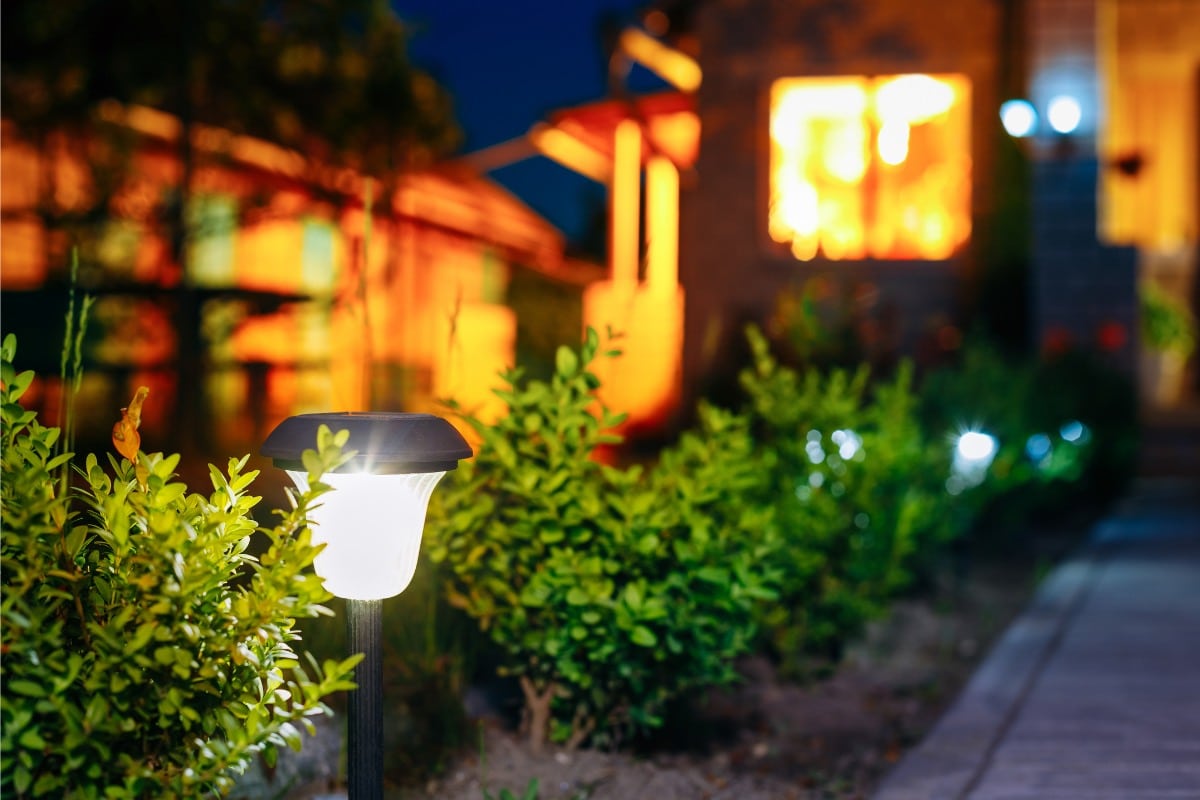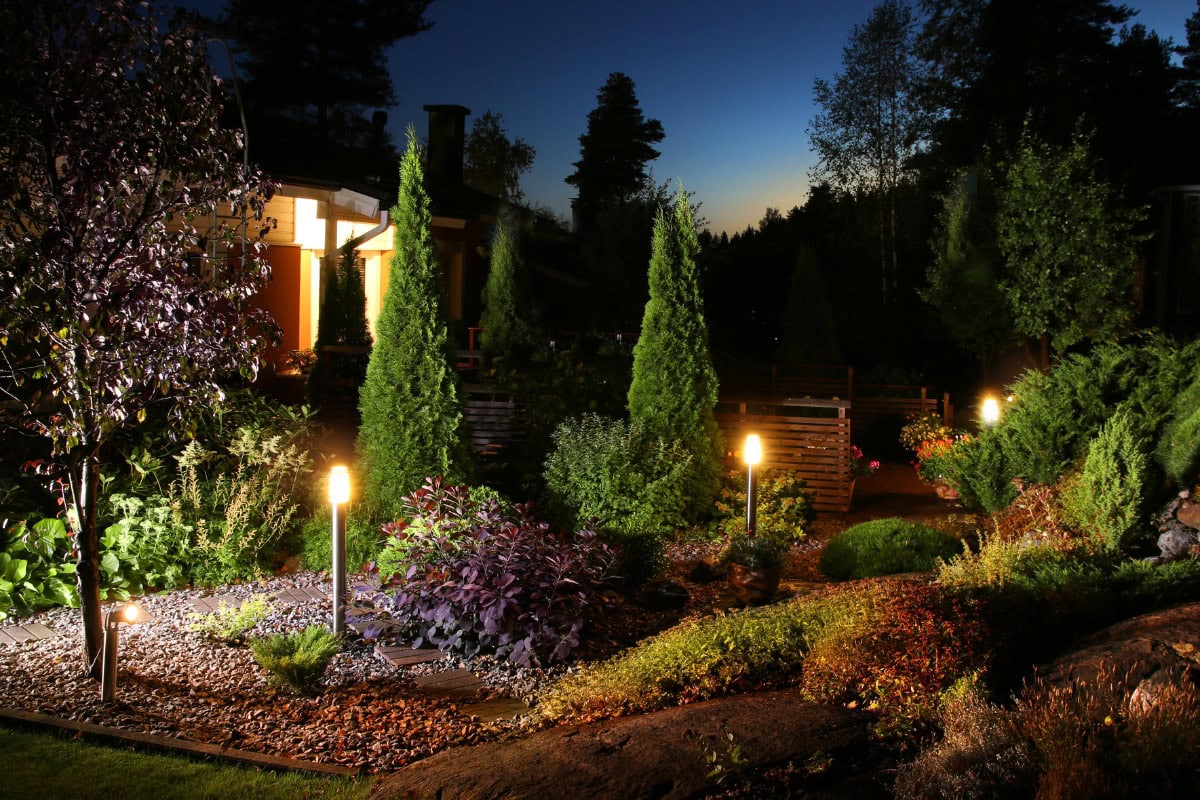There are several reasons why lighting should be added to the landscape: safety, security, tasking, and aesthetics.
Safety
Lighting can be used to help us move about the property without tripping on steps, stepping stones, tree roots, and other obstacles found in pathways and stairs around the home. Generally requiring a footcandle or less, the most common safety lighting is step lighting and path lighting.
It should be noted that the BOCA National Building Code of 1996 (Section 1207.2) requires 1 footcandle for every stair tread run for exterior stairways. The code does not require that the illumination be provided by low-voltage fixtures or that the light is spread evenly over the stairway. The requirement can be met with a single bright overhead fixture or individual fixtures mounted in each riser, or any of several other means. However, careful selection of lamps and fixtures will result in meeting the code requirements in an aesthetically pleasing way.
Security
Lighting can be used to discourage unwanted intruders and vandals by removing hiding places. While bright spotlights can be used for this purpose, they are not necessary when the project is planned properly. The same level of security is possible with carefully placed low-level lighting with a much more pleasing result for the homeowners and their neighbors.
Tasking
Lighting used to accomplish an activity is task lighting. It might be relatively high levels of light for reading or cleaning up or low levels for such activities as conversing or listening to music. A popular new task light is the Bar-B-Que lights used to help see while cooking on the grill. Actually, there are many types of fixtures and techniques that are used for task lighting. Controlling the amount, timing, and direction of the light is also an important aspect in task lighting design.
Aesthetics
Lighting installed to increase the enjoyment and beauty of the landscape is a common use for low-voltage lighting. Whether it is mature trees, flower beds, stone walls, a pond, or any other landscape feature, lighting can extend the time to enjoy and appreciate the beauty of your lawn and garden. The full range of techniques can be used to create natural and even unnatural effects.
In practice, the landscape lighting plan will frequently incorporate two or more of these purposes to provide a comprehensive lighting plan that will use just the right amount of light to do the job without creating light pollution or glare for the neighbors.
Why 12 Volt
The answer to “Why 12 volt rather than 15 volt or 10 volt” is simply that there were 12 volt components available at the time low-voltage landscape lighting was developed. Lamps and lamp holders for automobiles were 12 volt, so there was a ready supply of these critical components. The landscape lighting pioneer Bill Locklin used coffee and juice cans to make the fixtures and 12 volt batteries and transformers (although small by today’s standards) were available to safely power the system. No doubt if autos used 15 volt lamps, today’s landscape lighting would be based on 15 volt instead of 12.
As to why 12 volts rather than 120 volts, the answer is a little more complicated. Landscape lighting systems are frequently 120 volt based systems, particularly large commercial installations, however, most residential systems are low voltage. There are several reasons for this:
Safety
When using properly designed and manufactured products, low voltage lighting is safer to install and use than a line voltage system. The primary reason for this is that human skin provides sufficient resistance to a 12-volt current to prevent it from flowing through the body and damaging tissue and organs. Typically the worst that can happen is a blown fuse or breaker. It needs to be noted that cheap products are not always manufactured in a way to protect the user from contact with line voltage or an overheating situation.
Installation
Low voltage systems require less skills, special tools, and effort to install. Most localities do not require a license or a building permit to install low-voltage lighting. (Check with the city or county building department to learn of local requirements.) Fixtures are often mounted without the need for electrical boxes and wire can be run without the physical protection of conduit in most cases. No special cable is required for burial and burial depth is determined by common sense rather than code requirements. Line voltage systems almost always require a building permit and inspection by the local building official.
Flexibility
It is much easier to move low-voltage fixtures as the landscape changes due to plant growth or rearrangement. With low voltage systems, it is usually a simple matter of pulling the fixture out of the ground with the attaching wire and moving it to the new location. Line voltage wires are deeper and may be protected by conduit with electrical boxes attached.
Economy
Low voltage systems are typically less expensive to install not only because it can be a do-it-yourself project, but also because there are fewer components. This is usually true even though low-voltage systems require a transformer which is not required for line-voltage systems. Low voltage systems are also more efficient to operate and maintain. Operating costs can be as much as 30% less than line voltage installations.
Selection
In general, there are certainly more line voltage fixtures available, however, there are many outdoor lighting fixtures available that are designed to operate on low voltage. Additionally, there are low voltage lamps that will operate in unaltered line voltage fixtures, but line voltage lamps will not work in a low-voltage fixture without changing the lamp holder.
Line Voltage
There are applications that are best designed with line voltage systems (120 or 220 volt). Because of a phenomenon known as voltage drop, low voltage does not work well with very long cable runs. The size of the wire has to be increased significantly which adds greatly to the cost.
Line voltage may be the best choice if a lot of light is required. Lighting large trees, fountains, and statuary often requires a thousand watts or more to be properly illuminated. While it is certainly possible to do this with low voltage, the cost of the transformers and related components may make line voltage the best choice.









